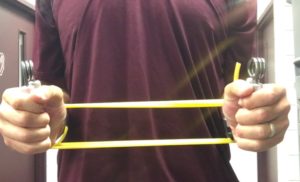By Mitch Hauschildt, MA, ATC, CSCS
Many of us use the miniband sidestep as part of our injury prevention, performance training, or rehab programming. Some refer to them as monster walks, banded shuffles or some other term, so for our purposes today, we are going to refer to it as the miniband sidestep and know that it refers to an exercises where we place a band around the lower leg and ask someone to move laterally.
The miniband sidestep gained a lot of popularity years ago when everyone began pointing to the glute medius as the culprit that is primarily responsible for patella femoral knee pain (and not the VMO). While I completely agree that the VMO has very little to do with patella femoral knee pain, I’m also not one to believe that the glute medius works on its own to control the femur, so we can have a long discussion as to what we really should be training to prevent or fix knee pain. But, we’ll save that for another day.
The reality is that many of us use some variation of this exercise, so I thought it would be good to show some good variations that we use in order to make the most of the movement to put our patients in the best possible position to be successful. Most of the time, we progress into them in a simple to complex manner (how they are listed here), but other times we do use variations for the sake of variation. I firmly believe that everything that we do should have a purpose, so I don’t generally make a habit of mixing in just for the sake of variation, but there is also a lot to be said about the mental and neurological advantages to constant variations within a workout.
- Miniband sidestep: The original and very simple version of the movement.
- Movement: Place a looped band around the ankles and walk laterally, keeping tension on the band and toes straight ahead.
- Pros: Simple movement that is easy to learn and simple to include in a home program or group training session. It isolates a the hip abductors, which can be an effective part of an activation strategy
- Cons: I prefer to train the larger system more whenever possible instead of training in isolation and this movement doesn’t fit into that strategy.
- Other Variations:
- Band around the Forefoot: Forces control of hip rotation
- Band around the Knees: Forces control of femoral rotation
- Band around the foot, ankle, and/or knee at the same time: Adds complexity and intensity to the movement by forcing more control at more areas simultaneously.
- X Band Walk: A variation that begins to incorporate the upper extremity, making the sidestep more effective. Anything that forces the shoulder stabilizers and glutes to work at the same time works across the back functional line, which is pivotal for our body to transfer force between the upper and lower extremities.
- Movement: Take a large band and step on it with the balls of the feet and then spin the band 180 degrees and grasp the band about waist height. This should form an “X” with the band. Pack the shoulders down and back while holding the band. Perform the lateral walk just as you would a normal miniband sidestep.
- Pros: This movement loads the posterior chain effectively while also working the abductors of the hip.
- Cons: A lot of people don’t have access to larger bands, so utilizing it in a home program isn’t as easy as with other versions.
- Gripper Miniband Sidestep: A variation of the miniband sidestep that involves the rotator cuff and stabilizers of the shoulder.

- Movement: Set up the sidestep with a band(s) around the lower leg as you prefer. Use 2 grippers (or gripping balls) and another miniband placed around the wrists. Have the client or patient squeeze the gripper as hard as possible and externally rotate and retract the shoulders to place tension on the band.
- Pros: Grip strength is associated with rotator cuff activity and the band will improve shoulder and upper back stability, thus the movement is a great integration movement and works very well for shoulder patients who need to facilitate the back functional line. I love this movement for early post surgical shoulder patients.
- Cons: It can be a bit difficult to set up with bands and grippers or balls.
- Brugger’s Walk: This is a variation of the sidestep that utilizes the classic Brugger’s postural
 positions.
positions.
- Movement: Utilize a long band or tubing and wrap the band around the forefoot, knees, and thighs. Perform with shoulders retracted and externally rotated.
- Pros: Bruggers forces a lot of postural correction work while loading the posterior chain. It can be used with simple tubing or a long band. It is a true integration movement that really incorporates the entire body.
- Cons: It can be complicated for the client or patient to learn the proper positioning early on.
- Other Variations:
- Wrap more times around the lower extremity: Forces more control of the lower extremity and in specific needed areas.
- Wrap behind the back: Forces more shoulder external rotation, but less posterior chain involvement.
- Ultimate Sandbag Sidesteps: One of my favorite variations because it involves a loading
 the posterior chain which oftentimes accelerates motor learning.
the posterior chain which oftentimes accelerates motor learning.
- Movement: Place the Ultimate Sandbag (USB) in the front loaded position with the USB in the crease of the elbows. The band should be connected through the suitcase handle and around the midfoot on each of the client’s feet. In this position, the band creates a triangle. Keep the posterior chain packed tight and stable and perform a sidestep.
- Pros: This movement is very functional, loading the posterior chain at a very high level while performing the sidestep.
- Cons: This is an advanced movement for more advanced clients and patients and takes some fairly specialized equipment.
Overall, the sidestep is a simple, but effective exercise that should be used in a lot of our rehab and injury prevention programming. Just as in any exercise, there has to be some sort of progression, which unfortunately is lost on a lot of clinicians and coaches. Here we have shown a few variations to get you some new ideas on how you can take a great movement and pour gasoline on it with load and complexity.


Leave a Reply